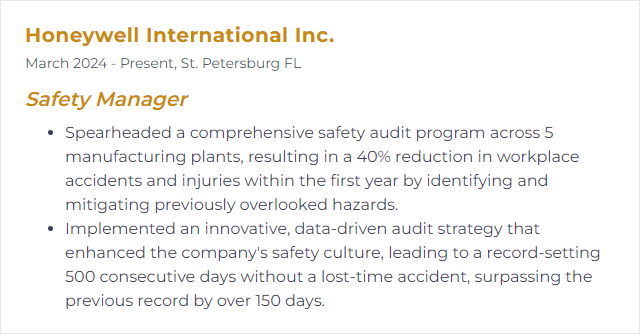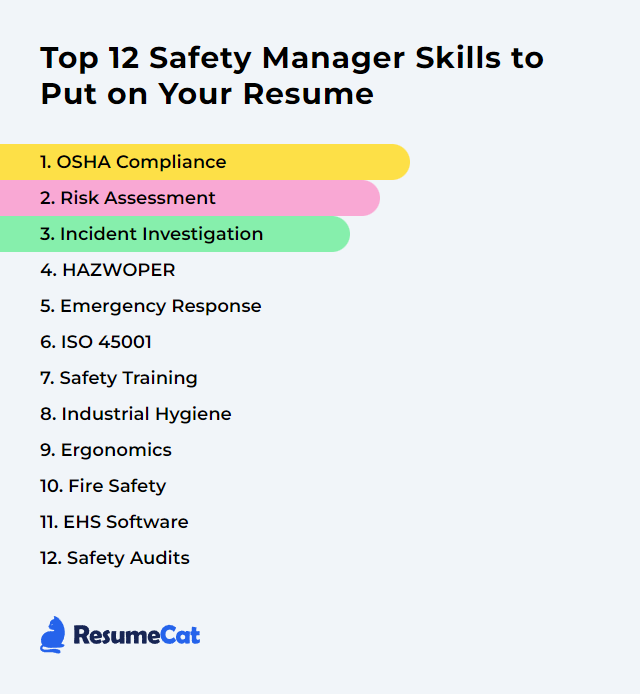Top 12 Safety Manager Skills to Put on Your Resume
Standing out as a safety manager means proving you can keep people healthy and operations humming without drama. The right skills on your resume tell that story fast—clear evidence you can spot hazards, drive compliance, respond under pressure, and build a culture where safety isn’t a slogan, it’s how work gets done.
Safety Manager Skills
- OSHA Compliance
- Risk Assessment
- Incident Investigation
- HAZWOPER
- Emergency Response
- ISO 45001
- Safety Training
- Industrial Hygiene
- Ergonomics
- Fire Safety
- EHS Software
- Safety Audits
1. OSHA Compliance
OSHA compliance means building and maintaining workplace practices that meet Occupational Safety and Health Administration standards—policies, procedures, training, hazard controls, and recordkeeping that keep people safe and the organization on solid legal ground.
Why It's Important
Strong compliance cuts injuries, fines, and downtime. It bolsters trust, keeps operations steady, and signals to every employee that safety isn’t optional—it’s built in.
How to Improve OSHA Compliance Skills
Track changes: Review relevant standards regularly. Match requirements to your operations and update controls fast when things shift.
Run tight audits: Schedule routine inspections and targeted spot checks. Close gaps promptly and verify fixes.
Train with purpose: Deliver role-based training that’s practical and refreshed often. Validate understanding, not just attendance.
Build a real program: Formalize a safety and health program with employee involvement, hazard identification, prevention, and continuous improvement.
Keep clean records: Maintain accurate injury/illness logs, inspections, training, and corrective actions. Consistency matters.
Open the channel: Make reporting easy and retaliation unthinkable. Act on concerns quickly.
Respond quickly: When hazards surface, address them now—temporary safeguards, permanent fixes, documented follow-up.
Use available help: Leverage reputable compliance guides, consultation services, and templates to standardize and scale your approach.
How to Display OSHA Compliance Skills on Your Resume
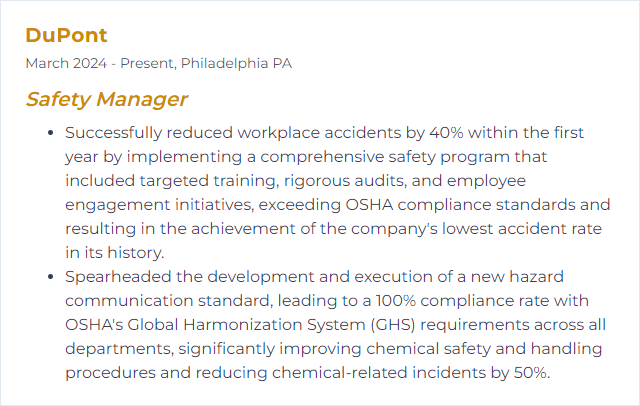
2. Risk Assessment
Risk assessment is the disciplined process of spotting hazards, analyzing likelihood and severity, and deciding on controls that reduce risk to a tolerable level—then checking that those controls actually work.
Why It's Important
It’s the backbone of prevention. You can’t control what you can’t see, and you can’t prioritize what you haven’t measured.
How to Improve Risk Assessment Skills
Standardize the method: Use consistent tools for identification, scoring, and prioritization. Make it repeatable and auditable.
Bring workers in: Frontline insights reveal hidden hazards and practical controls you won’t find on a form.
Leverage tech: Use assessment and inspection software to capture data, trend risks, and trigger actions automatically.
Reassess on change: New equipment, processes, chemicals, or layouts? Update the assessment before exposure ramps up.
Validate controls: Verify effectiveness with monitoring, observations, and performance metrics. Adjust as needed.
How to Display Risk Assessment Skills on Your Resume
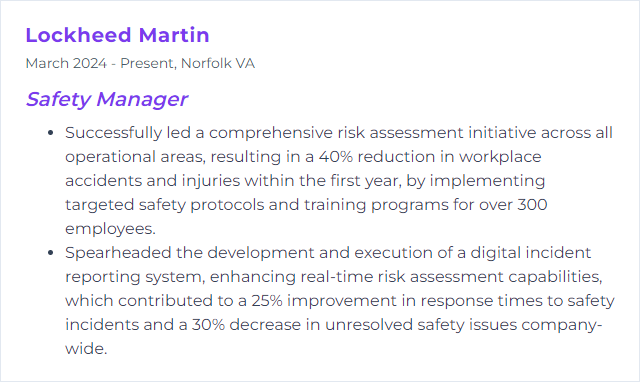
3. Incident Investigation
Incident investigation digs into what happened, why it happened, and what will prevent it from happening again—beyond blame, into systems, decisions, and conditions.
Why It's Important
Done well, it uncovers root causes, drives effective corrective actions, and stops repeat events. It also supports compliance and strengthens credibility with workers and regulators.
How to Improve Incident Investigation Skills
Train investigators: Teach methods like 5 Whys, fishbone, and barrier analysis. Build interviewing and evidence-handling skills.
Move quickly: Secure the scene, collect perishable evidence, and capture fresh witness statements.
Use structured tools: Standard forms, timelines, causal factor charts—clarity in, clarity out.
Include stakeholders: Mix operations, maintenance, safety, and worker reps. Multiple views, fewer blind spots.
Document and verify: Record facts, analysis, and actions. Audit corrective actions for completion and effectiveness.
Feed learning back: Share insights and update procedures, training, and risk assessments accordingly.
How to Display Incident Investigation Skills on Your Resume
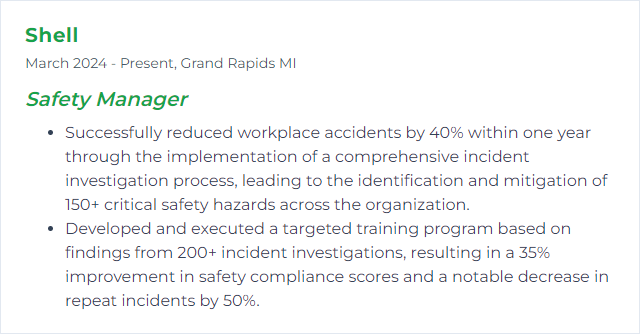
4. HAZWOPER
HAZWOPER (Hazardous Waste Operations and Emergency Response) covers the training, procedures, and protections required for work with hazardous substances—cleanup operations, treatment and storage, and emergency response.
Why It's Important
It protects workers, communities, and the environment from chemical exposures and incidents, while anchoring regulatory compliance for hazardous operations.
How to Improve HAZWOPER Skills
Deliver role-based training: Initial and refresher courses tied to actual site hazards and tasks. Make drills realistic.
Exercise often: Tabletop and full-scale drills to sharpen coordination, command, and decontamination steps.
Keep PPE right: Select appropriate protection levels, inspect routinely, and replace before performance degrades.
Audit high-risk tasks: Focus on entry, sampling, transfer, and waste handling. Close gaps with engineered and administrative controls.
Modernize monitoring: Use direct-reading instruments and log data to trend exposures and guide controls.
Stay current: Track regulatory updates and revise site safety and health plans promptly.
How to Display HAZWOPER Skills on Your Resume

5. Emergency Response
Emergency response is how an organization prepares for, communicates during, and recovers from unexpected events—medical, fire, chemical, weather, security—without losing control or endangering people.
Why It's Important
Seconds count. A prepared response reduces harm, limits damage, ensures regulatory obligations are met, and gets operations back online faster.
How to Improve Emergency Response Skills
Risk-profile your site: Identify credible scenarios and worst cases. Prioritize by impact and likelihood.
Write living plans: Clear roles, evacuation and sheltering, spill control, medical response, and continuity steps—versioned and tested.
Train and drill: Mix classroom, hands-on, and unannounced exercises. Evaluate realism and readiness, then refine.
Harden communications: Build redundancy—mass notifications, radios, backups. Establish plain-language protocols.
Coordinate externally: Align with local fire, EMS, and emergency management. Share site info and pre-plan access.
Review after action: Capture lessons, fix gaps, and update plans, maps, and contact trees quickly.
How to Display Emergency Response Skills on Your Resume
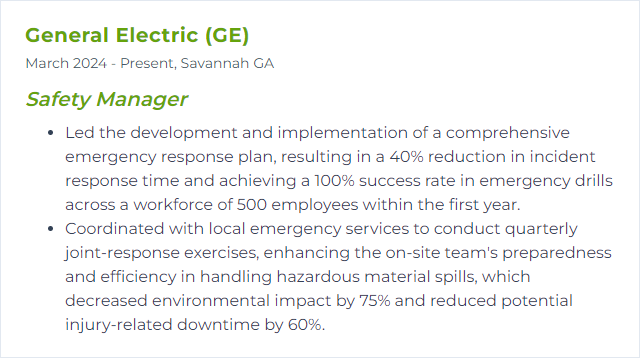
6. ISO 45001
ISO 45001 is the international framework for occupational health and safety management systems—policy, planning, support, operations, performance evaluation, and improvement wrapped into one structure.
Why It's Important
It organizes safety into a system that reduces risk, embeds worker participation, and demonstrates due diligence to stakeholders across borders.
How to Improve ISO 45001 Skills
Run a gap analysis: Compare current practices to the standard’s clauses. Prioritize fixes with clear owners and dates.
Engage leadership and workers: Top management sets direction; workers shape practical controls. Both are non-negotiable.
Strengthen competence: Train employees on their OH&S roles. Refresh routinely and verify effectiveness.
Investigate and learn: Build a rigorous incident and near-miss process that feeds into corrective and preventive actions.
Measure what matters: Track leading and lagging indicators. Review at management meetings and act on trends.
Audit routinely: Calibrate with internal audits and independent reviews. Close findings quickly.
Drive PDCA: Plan, Do, Check, Act—repeat. Improvement never stops.
How to Display ISO 45001 Skills on Your Resume
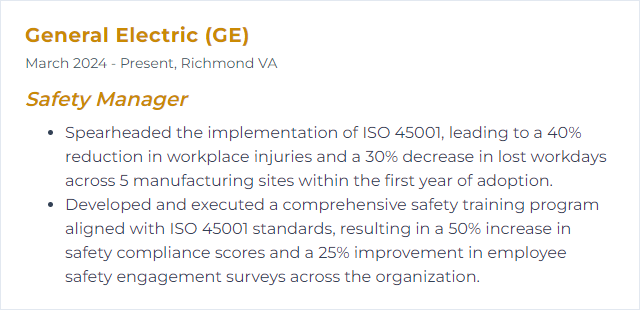
7. Safety Training
Safety training equips people to spot hazards, use equipment correctly, follow procedures, and respond when things go wrong. For a safety manager, it’s about designing programs that stick and prove their value.
Why It's Important
Training reduces incidents, improves confidence, and helps meet legal requirements. It also shapes culture—what gets taught gets done.
How to Improve Safety Training Skills
Tie training to risk: Build curricula from your risk assessments and job hazard analyses. Relevance drives retention.
Make it interactive: Simulations, hands-on practice, scenario work, and microlearning beat slide decks.
Blend delivery: Mix classroom, e-learning, and on-the-job coaching. Track completions and competency.
Check understanding: Use practical assessments and observations, not just quizzes. Close gaps fast.
Refresh regularly: Schedule refreshers and toolbox talks. Update content when processes or risks change.
Recognize achievement: Certifications and recognition boost engagement and accountability.
How to Display Safety Training Skills on Your Resume
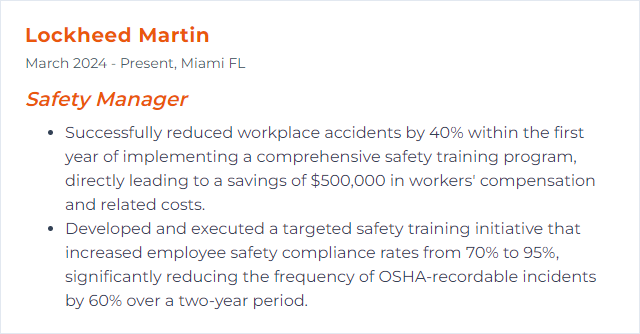
8. Industrial Hygiene
Industrial hygiene anticipates, recognizes, evaluates, and controls chemical, physical, biological, and ergonomic hazards—so work doesn’t make people sick.
Why It's Important
It safeguards long-term health, reduces claims and lost time, and aligns programs with regulatory expectations and ethical duty.
How to Improve Industrial Hygiene Skills
Map exposures: Conduct baseline and periodic surveys. Inventory agents, tasks, and worker groups.
Sample smart: Use validated methods for air, noise, heat, and surface contamination. Calibrate and document rigorously.
Apply the hierarchy: Eliminate or substitute where possible; engineer controls next; then admin controls; PPE last, not first.
Train and enforce: Teach correct PPE use, hygiene practices, and decontamination. Observe and correct in the field.
Monitor outcomes: Track exposure data and health surveillance results. Adjust controls based on trends.
Review often: New processes and materials mean new risks. Update assessments and controls accordingly.
How to Display Industrial Hygiene Skills on Your Resume
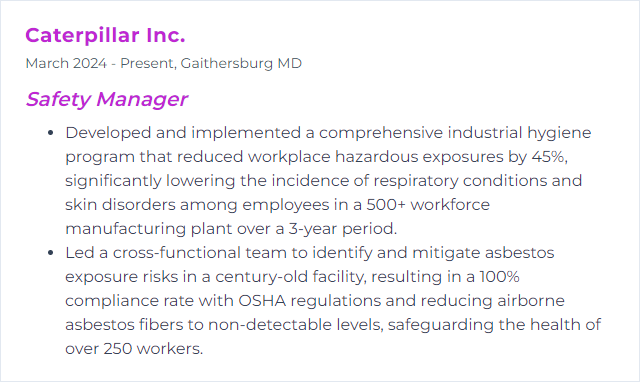
9. Ergonomics
Ergonomics shapes tasks, tools, and workspaces to fit people, not the other way around—reducing strain and boosting performance.
Why It's Important
Good ergonomics cuts musculoskeletal disorders, improves comfort, and lifts productivity. Small design tweaks, big results.
How to Improve Ergonomics Skills
Assess tasks: Use structured tools (e.g., RULA, REBA) and observation to find high-risk postures, forces, and repetition.
Tailor workstations: Adjustable heights, reach zones, seating, lighting, and tool selection aligned to the worker and task.
Coach habits: Teach neutral postures, safe lifting, and pacing. Encourage microbreaks to reset muscles and focus.
Design workflows: Reduce lifts, carries, and twists with job rotation, mechanical assists, and better material flow.
Check and refine: Gather feedback and track discomfort reports. Iterate until risk scores drop.
How to Display Ergonomics Skills on Your Resume
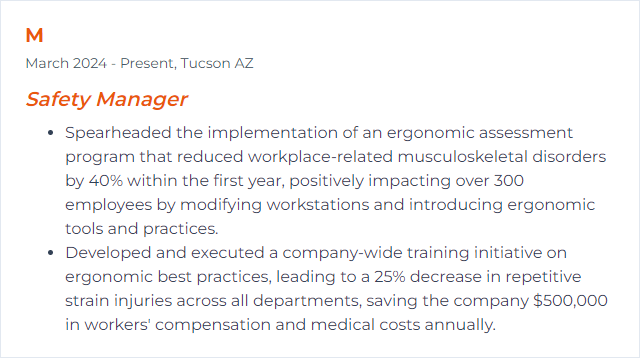
10. Fire Safety
Fire safety blends prevention, detection, suppression, and evacuation planning—engineered systems plus trained people moving the right way at the right time.
Why It's Important
It protects lives and property, reduces business interruption, and meets legal requirements that don’t bend when alarms sound.
How to Improve Fire Safety Skills
Assess and mitigate: Identify ignition sources, fuels, and vulnerable areas. Control hot work, housekeeping, and electrical risks.
Maintain systems: Inspect alarms, detection, extinguishers, sprinklers, and fire doors on schedule. Fix deficiencies promptly.
Train everyone: Teach alarm response, extinguisher use, and evacuation procedures. Assign wardens and backups.
Drill realistically: Practice different scenarios and blocked exits. Time evacuations and improve wayfinding.
Keep paths clear: Mark egress routes, light them well, and keep them unobstructed. Verify daily.
Stay compliant: Align with applicable fire codes and standards; document everything.
How to Display Fire Safety Skills on Your Resume
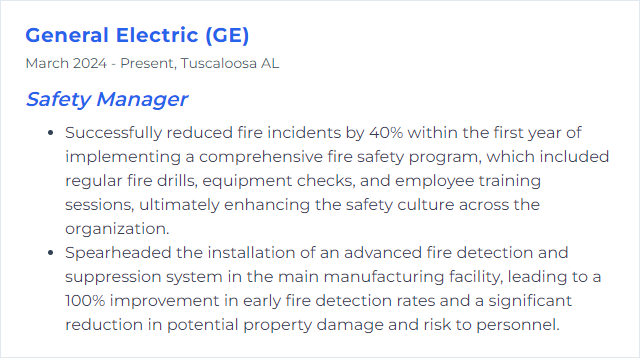
11. EHS Software
EHS software centralizes incidents, audits, corrective actions, training, chemicals, and metrics—putting your safety program on rails with data you can act on.
Why It's Important
It tightens compliance, accelerates response, reveals trends, and proves performance to leadership. Less chasing spreadsheets, more preventing harm.
How to Improve EHS Software Skills
Simplify the experience: Configure forms and workflows to match how people work. Fewer clicks, better data.
Customize and scale: Tailor fields, roles, and permissions. Ensure the system grows with sites and complexity.
Strengthen reporting: Build dashboards for leading and lagging indicators. Automate distribution and reviews.
Integrate systems: Connect HR, learning, maintenance, and operations for clean data and closed-loop actions.
Go mobile: Enable offline inspections, photo capture, and QR-tagged assets on the floor.
Enable real-time alerts: Trigger notifications for incidents, escalations, and overdue actions.
Train and support users: Provide quick-start guides, role-based training, and responsive help.
Keep regulations current: Update templates and workflows when rules change. Version control matters.
Listen and iterate: Capture user feedback and improve configurations continuously.
How to Display EHS Software Skills on Your Resume
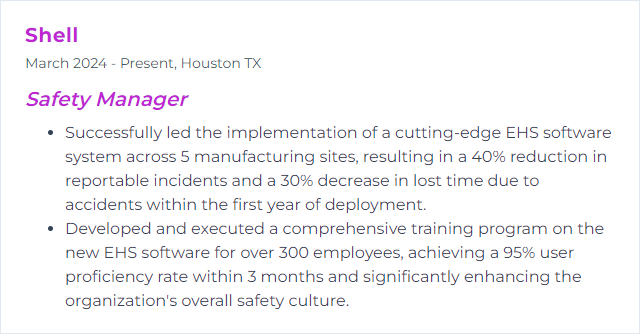
12. Safety Audits
Safety audits are structured evaluations of programs, practices, and compliance—evidence-based checks that what should happen actually does.
Why It's Important
Audits uncover hazards, verify controls, and drive accountability. They reduce incidents, protect the organization, and anchor improvement.
How to Improve Safety Audits Skills
Set a clear scope: Define objectives, standards, and sampling strategies. Use tailored checklists, not generic ones.
Gather evidence well: Observe work, review documents, and interview workers. Photograph conditions and tag findings.
Use digital tools: Capture data consistently, trend results, and assign corrective actions with due dates and owners.
Prioritize by risk: Rank findings by severity and likelihood. Fix high-risk issues first and verify completion.
Share results: Communicate plainly with leadership and workers. Transparency builds trust and momentum.
Close the loop: Re-audit to confirm effectiveness. Update procedures and training based on what you learn.
How to Display Safety Audits Skills on Your Resume
